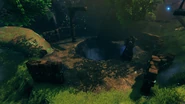Dvergr Excavation Sites are one of the types of Dvergr structures located throughout the Mistlands. A camp outlined by wooden stake walls surrounding a pit containing partially-excavated Giant Remains, it is one type of Dvergr structure and is home to Dvergr rogues and mages. Each inhabited Dvergr Excavation Site contains a Dvergr component crate, an important crafting component for progression.
One of the three Dvergr Excavation Site variants has been ruined, being abandoned by the Dvergr, and is instead home to groups of Seekers. The central pit of this variant is empty, its Giant Remains having already been fully excavated.
Location[]
Dvergr Excavation Sites are found in the Mistlands.
Description[]
Dvergr Excavation Sites are simple uncovered structures built by the Dvergr around Giant Remains, which they appear to be in the process of mining for Black marble. Each Excavation Site is outlined by Dvergr wood walls surrounded by sets of Dvergr sharp stakes, with multiple blue mist-dispelling lights, and with up to 6 Dvergr lanterns atop the walls. Inside the walls are a wooden Dvergr wagon, as well as multiple stacked blocks of black marble (including Black marble 1x1x1 and Black marble 2x2x2), and a Dvergr Ward which protects the entire structure. There may also be up to two piles of Dvergr Crates, with up to five Crates per pile.
At the center of the Dvergr Excavation Site is a pit in the ground, inside which is part of some Giant Remains, below some Dvergr-made mining apparatus constructed of wood and metal.
Variants[]
There are three variants of Dvergr Excavation Site:
- The first variant is built around a Giant Skull (containing a Soft tissue deposit), above which is a hook and chain suspended from a wooden tripod. The Dvergr component crate is located on the ground inside the walls, next to the Ward.
- The second variant is built around Giant Ribs, above which is a hook and chain suspended from a wooden crane. The Dvergr component crate is located atop the wagon.
- The third variant is ruined. There are no Dvergr there, but instead groups of Seekers; the Giant Remains are completely absent from the empty pit beneath the wooden crane, and very few black marble blocks remain. Many of the walls are missing, the single intact lamppost is missing its blue mist-dispelling light, and no Dvergr sharp stakes nor Dvergr lanterns are present. Finally, there is no Dvergr component crate, and instead of the usual arrangements of Crates, a total of six Crates may be found, spread around the walls in groups of 1-3.
Gallery[]
Notes[]
- The wagons present in inhabited Dvergr Excavation Sites are very similar to the one used by Haldor, except that the latter is indestructible and appears to be laden with various goods and equipment.
- Like other Dvergr structures, the Dvergr Excavation Site may be destroyed or deconstructed (including mining its Giant Remains) to yield various valuable materials. However, doing so can be very dangerous: Since the inhabited variants of Excavation Site are protected by a Dvergr Ward, any damage done to any part of the structure (even the Giant Remains) by a player will instantly anger all nearby Dvergr, causing them to become hostile and attack nearby players. However, if the structure is damaged by non-player sources, such as Gjall or Seekers, the Dvergr will not become aggressive towards the player.
- The wooden and metal walls and mining devices of the structure as well as the Dvergr furniture can provide Wood and/or Copper scrap when destroyed; the hook and chain can provide Chains. The wagon and each Crate can provide Fine wood, while the latter may also provide Soft tissue.
- Like other Dvergr structures, the Dvergr Excavation Site is always in a state of disrepair, with each individual component (including furniture) being damaged by a random amount. This contributes to their weathered appearance, but also makes them often surprisingly easy to destroy parts of, even with the Dvergr Ward intact.
See also[]
- Dvergr (race)
- Other Dvergr-made Mistlands Points of Interest:



